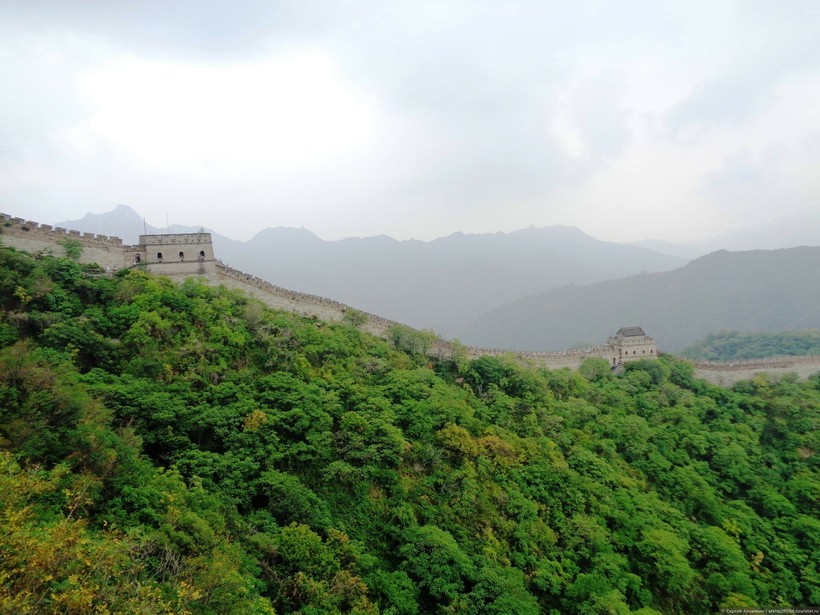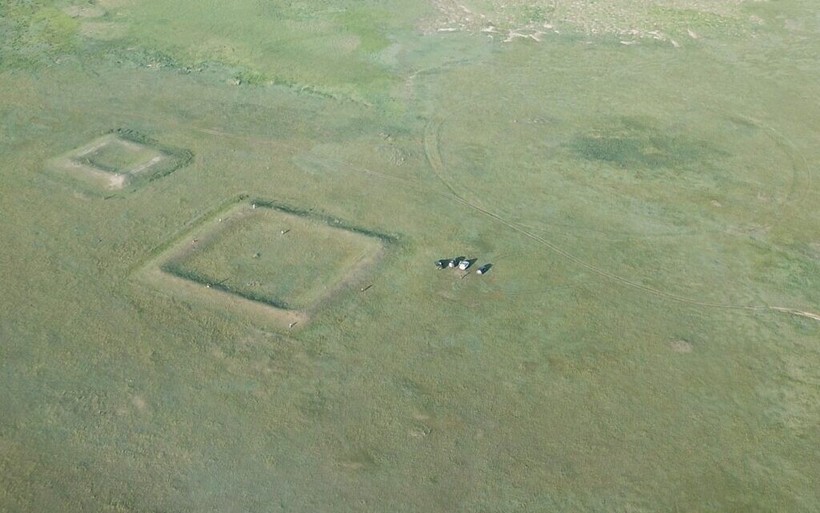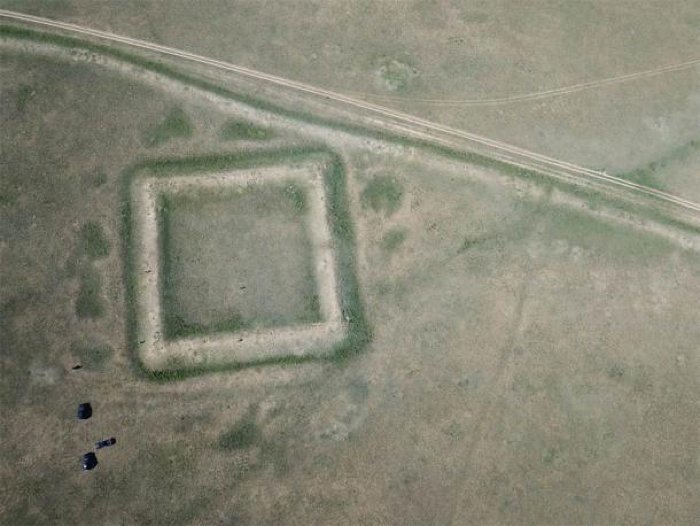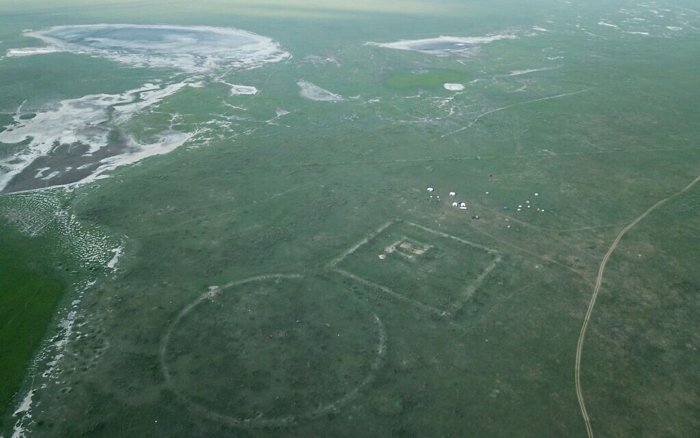The Great Wall of China is still of great interest to historians. Few people know, but some parts of this grandiose structure are not in China. Fragments of buildings, which are also referred to as the defensive lines of the ancient Chinese state, are located in the east of Mongolia and even in Russia. Scientists from Israel explored the northern part of the ancient fortification and came to the conclusion that it was not built to defend against the attacks of nomads. These structures are not at all like those sections of the wall that tourists visit in China.
Archaeologists from Israel have concentrated their attention on the northern section of the wall with a length of more than 700 kilometers. For two years, they explored that part of the structure, which is located mainly on the territory of Mongolia. It differs from the rest of the sites and consists of disparate fragments, which are small structures of a rounded or rectangular shape. In their opinion, it is quite low, which does not allow it to perform the functions of a protective structure. But it is great for observing herds of pets, for example.
Researchers suggested that these sections of the wall were not built for defense, but for control and observation. This is not a continuous defensive line, the buildings are located in convenient valleys along which cattle may have been driven. These towers made it possible to count the number of livestock and, probably, calculate the amount of tax, but other goals are not excluded. These fragments of the wall could also serve as customs points that controlled the passage of trade caravans.
The northern sections of the wall are not the most ancient, although they were built using simpler technologies. Their exact age has not been established, but most likely they were built at the end of the 1st millennium AD, when China was going through a period of fragmentation and consisted of different kingdoms ruled by separate dynasties. Perhaps these sections of the wall were built during the Liao dynasty, which was just in the north of modern China and in the east of Mongolia.
The fortifications are not always well read on the ground, so the researchers resorted to aerial photographs. Scientists also used a lot of archival materials to find out the purpose of the northern sections of the wall. These structures are really different from all the famous fragments located in China, so it is very likely that they were built for a different purpose. Perhaps scientists will reconsider their assignment to the Great Wall of China, because if the conclusions of Israeli experts are correct, then the buildings are not part of it.








Customer
I don’t think the title of your article matches the content lol. Just kidding, mainly because I had some doubts after reading the article.
Customer
Your article helped me a lot, is there any more related content? Thanks!
Customer
Thanks for sharing. I read many of your blog posts, cool, your blog is very good. https://accounts.binance.com/ru-UA/register-person?ref=WTOZ531Y
Customer
AASs are prescription-only medicines that are typically taken with out medical advice to increase muscle mass
and enhance athletic performance. They can be found as a tablet to be taken orally with or with out food once a day or
three or four instances a day. A variety of unwanted effects can happen when anabolic steroids are misused, starting from mild
results to ones which might be dangerous and even life-threatening.
The side effects of steroids can be explained by the excess androgen and anabolic drug levels
present in the body. It can take up to four months to restore the body’s pure
testosterone ranges if taking excessive doses for an extended time frame 28.
Pregnant girls who use anabolic steroids
are susceptible to harming their unborn baby. To be safe, anabolic steroid use should be
stopped no less than 4 months before falling pregnant, as nicely as during being pregnant 37, 38.
If used for longer periods, corticosteroid medication must be gradually tapered off to permit the adrenal gland to gradually
take over its normal perform. Stopping too shortly may end up in withdrawal signs and a doubtlessly life-threatening adrenal
crisis. Anabolic steroids can be found by prescription and are used to treat situations that end in abnormally low testosterone levels (hypogonadism).
This article takes a deeper look into steroids and lays out every
thing you should know on the subject. Using steroids can affect
your capability to sleep, particularly when taken earlier than going to mattress within the
evening. This is why many physicians recommend
taking the entire every day dose within the morning.
Many young boys and adults turn into too involved with their physical look, which may lead to a disordered
physique picture, also identified as muscle dysmorphia.
This is a mental well being condition where people are continuously worrying concerning the flaws in their bodily appearance.
If you’ve ever puzzled how the cumbersome weight lifters down at the health club get so big, typically it isn’t through a strict routine of weight lifting
and food regimen, however via the illegal use of
steroids. It’s finest to focus on sustainable, wholesome
ways to build muscle and keep match.
Cypionate has a half-life of approximately eight days, whereas Enanthate and Propionate have a brief elimination half-life
of about 4.5 days. For instance, Testosterone Undecanoate has
a protracted half-life of over 20 days, and Phenylpropionate has a brief half-life
of lower than three days. And with that, I ought to add that every little thing you
learn right here is predicated on my analysis and expertise.
I purpose to share, educate, and help you attain your targets whereas I proceed
reaching and exceeding mine.
Whichever way you go, you must ensure all of the steroids are cleared out of your system before beginning PCT.
This is where figuring out your steroid half-lives and clearance instances is essential.
Reading about different people’s experiences with
certain steroids on internet forums and social media doesn’t put together you for what YOU
will expertise with the same steroid.
As A Outcome Of of the intimate position of testosterone in erectile perform, erectile
dysfunction can develop as a post-cycle aspect effect of AAS
use. Nevertheless, it should be kept in thoughts that erectile dysfunction in an AAS consumer just isn’t essentially the outcome of AAS use per se and might be a symptom of
an underlying psychiatric dysfunction. The presence of inflexible
morning or night time erections, sudden onset, intermittent course and quick length are a good indication of a psychogenic trigger.
Lack of morning or night erections, a gradual onset, progressive course,
or lengthy duration suggest an natural trigger.
With the exception of its effect on Lp(a), AAS
use – particularly use of 17α-alkylated AAS – leads to a more atherogenic lipid profile (see Desk 1).
This would possibly help explain the outcomes of
a population-based cohort study by which men that examined constructive for AAS
had twice the cardiovascular morbidity and mortality fee as those that examined negative (149).
This is just beneficial for long-time, extremely skilled, or older users
who don’t have any considerations about natural testosterone levels.
Some consider very long cycles ranging from
3 to 9 months can deliver everlasting gains. Testosterone Enanthate (Cypionate) is the compound mostly used in a long cycle.
As expected, the heightened threat of great side effects of those extra-long steroid cycles makes it a
technique that shouldn’t be taken frivolously.
Anabolic steroids are orally-ingested, synthetic (man-made) medicine that
act like testosterone. They trigger development and growth of male sexual organs, secondary intercourse characteristics,
and will increase in muscle size and energy. However in distinction to males who will gain little muscle
with these “milder” steroids, women will find that these are greater than highly effective enough to advertise good muscle positive aspects, together with fats loss and efficiency benefits.
The time scale of 10 to 12 weeks makes it potential to mix virtually any compounds
with completely different size esters, primarily allowing you to tailor either a
bulking or slicing cycle in accordance with your personal objectives.
Corticosteroids are one other well-known group, however corticosteroids have different medical uses29.
They’re nice for decreasing irritation and overactive
immune response, but they won’t serve you for muscle
progress.
Other steroid users could “pyramid” their steroids, starting with a low dose and gradually increasing the dose,
frequency, or number of anabolic steroids taken, then petering out to finish a cycle.
Users believe that stacking enhances the effects of every individual drug, pyramiding allows the body to get used to high doses of steroids, and
steroid-free periods help the body recuperate from the drugs.
The truth is that we still don’t know exactly how steroids do what they
do in phrases of athletic performance. Researchers who had been using a variety
of rodents, dogs, cats, monkeys, and home livestock to review the effects of anabolic steroids found this testing was not useful,
despite the precise fact that the results had been very constant.
References:
PedsElite
Customer
Thank you for your sharing. I am worried that I lack creative ideas. It is your article that makes me full of hope. Thank you. But, I have a question, can you help me?
Customer
Thank you for your sharing. I am worried that I lack creative ideas. It is your article that makes me full of hope. Thank you. But, I have a question, can you help me?
Customer
Thank you for your sharing. I am worried that I lack creative ideas. It is your article that makes me full of hope. Thank you. But, I have a question, can you help me?
Customer
I don’t think the title of your article matches the content lol. Just kidding, mainly because I had some doubts after reading the article.
Customer
Thank you for your sharing. I am worried that I lack creative ideas. It is your article that makes me full of hope. Thank you. But, I have a question, can you help me?
Customer
legal muscle building steroids
References:
http://www.yetutu.top
Customer
basic structure of a steroid
References:
git.365zuoye.com
Customer
natural anabolic supplements
References:
https://git.saidomar.fr/
Customer
anabolic steroid side effects
References:
git.2weisou.com
Customer
best legal cutting supplement
References:
code.dsconce.space
Customer
steroids make you gain weight
References:
tiktoksi.com
Customer
Your article helped me a lot, is there any more related content? Thanks!
Customer
Thank you for your sharing. I am worried that I lack creative ideas. It is your article that makes me full of hope. Thank you. But, I have a question, can you help me?
Customer
Thanks for sharing. I read many of your blog posts, cool, your blog is very good. binance
Customer
Your point of view caught my eye and was very interesting. Thanks. I have a question for you.
Customer
dianabol and test cycle
References:
valley.md
Customer
Your point of view caught my eye and was very interesting. Thanks. I have a question for you. https://accounts.binance.com/register?ref=P9L9FQKY
Customer
dianabol only cycle reddit
References:
testosterone trenbolone dianabol cycle (https://Trade-britanica.trade/wiki/Dianabol_and_take_a_look_at_cycle_guide_results_Dosage)
Customer
dianabol beginner cycle
References:
oral dianabol Cycle (karayaz.ru)
Customer
high roller varies
References:
Blackcoin.co
Customer
what is a high roller
References:
what is a high roller in poker (support.mikrodev.com)
Customer
what is a vip high roller
References:
review – http://www.instructables.com,
Customer
what is a high roller, https://www.generation-n.at, at downtown casinos
Customer
what is a high roller in vegas
References:
high roller rooms, matkafasi.Com,
Customer
online casino high roller
References:
blackcoin.Co
Customer
what is a high roller in casino
References:
what is A high roller in poker, http://karayaz.Ru/user/castwar88,
Customer
Way cool! Some extremely valid points! I appreciate you writing this write-up plus the rest of the site is also really good.
Customer
Can you be more specific about the content of your article? After reading it, I still have some doubts. Hope you can help me.
Customer
Big thanks for this amazing post. Looking forward to reading more from you!
Customer
I don’t think the title of your article matches the content lol. Just kidding, mainly because I had some doubts after reading the article. http://1108465.cryptostarthome.com
Customer
Thank you, your article surprised me, there is such an excellent point of view. Thank you for sharing, I learned a lot. http://merkle-roots.cryptostarthome.com
Customer
Thanks for sharing. I read many of your blog posts, cool, your blog is very good.
Customer
70918248
References:
none, https://www.thebranddna.se/the-power-of-effective-communication-in-business,
Customer
70918248
References:
None (https://Yam193293393.Com/2022/11/18/3-秋ジャガイモ①/?/)
Customer
70918248
References:
none [https://snapliftx.com/saudi-visa-for-uk-citizens-a-complete-guide-to-visiting-saudi-arabia/]
Customer
70918248
References:
none (naturaverdebiobaby.it)
Customer
70918248
References:
none
Customer
70918248
References:
None (https://Alpiocafe.Com/)
Customer
70918248
References:
None
Customer
70918248
References:
none (Ervin)
Customer
70918248
References:
long term steroid therapy (Gladys)
Customer
70918248
References:
Brad Castleberry Steroids
Customer
70918248
References:
best steroid cycle for beginner – https://excellenceacademy.co.in/kazino-oyunlari-real-pul-qazandiran-oyunlar-371,
Customer
70918248
References:
steroids for women weight loss (https://www.aeeaatletismo.es/)
Customer
70918248
References:
Effect of steroids (https://www.puriasia.com/Glassbottomboatbalisightseeingtourolehayana)
Customer
70918248
References:
medical steroid – andrebello.com.br –